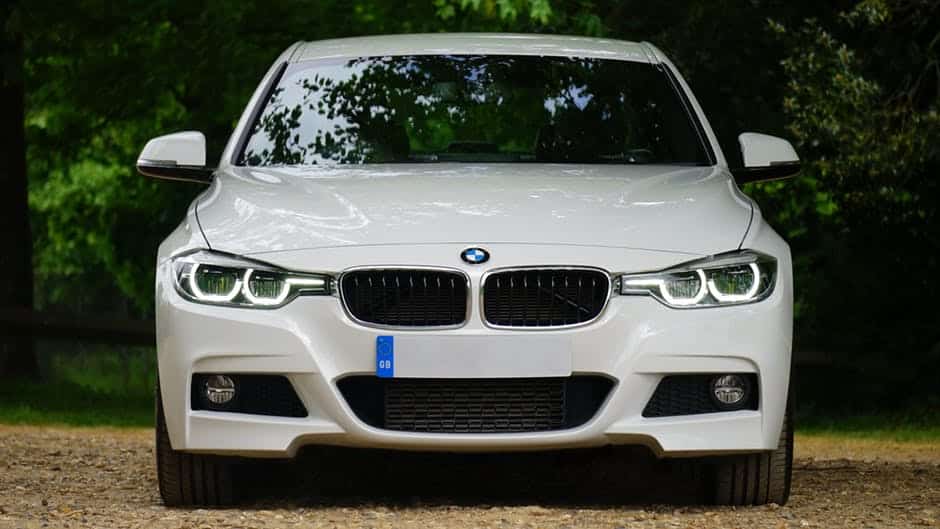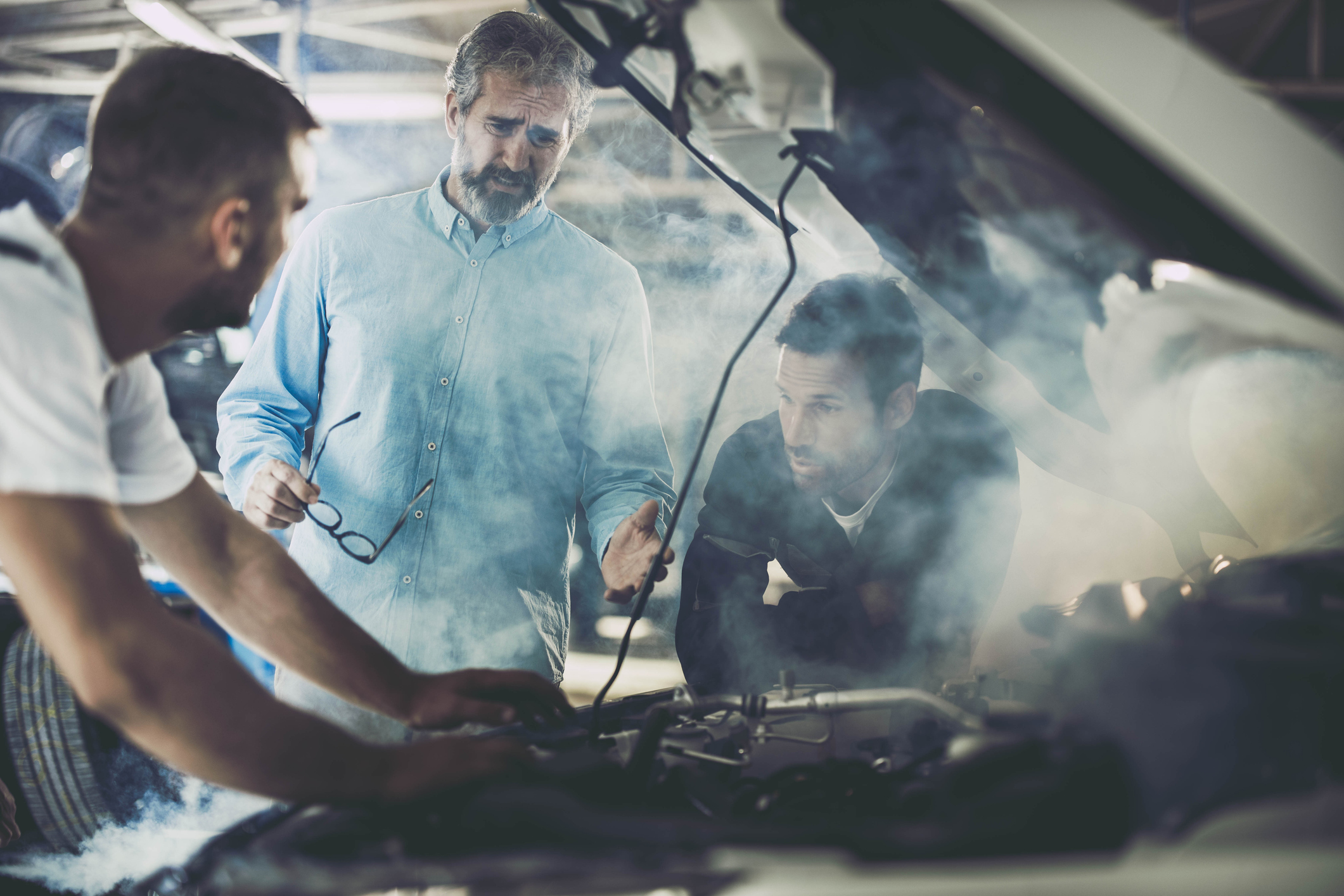Vehicles usually overheat in extremely hot weather, so what should you do if your BWM is overheating? Fortunately, today’s BMWs feature sophisticated cooling systems, including engine temp sensors and computer-monitored electric fans, designed to keep your engine running optimally no matter what the season. But overheating is still a possibility, and it’s important to know what to do in the event it happens to you.
If you see that your engine is starting to overheat, you’ll want to turn off the AC and turn on the heat to get the heat away from your engine. This reduces the burden on the cooling system. If that doesn’t work, pull over and turn off the engine. Once the car has cooled, open the hood and check the coolant.
You can do your part to prevent further damage to your BMW’s engine if you can get it cooled down before it overheats and the engine fails. Then, you can get the car safely to your trusted mechanic.

Signs of Overheating
Not sure what an overheating engine looks like?
- Temperature Gauge in the Red Zone: One of the most straightforward signs of an overheating engine is the reading on your BMW’s temperature gauge. If it’s in the red or hot zone on the dashboard, it’s a clear indication that your engine is running too hot. In modern BMWs, this gauge is usually digital, providing an accurate representation of the engine’s temperature.
- Steam or Smoke Emanating: If you notice steam or smoke coming from under the hood or around the engine bay, it’s a definite sign of overheating. This visual cue may also be accompanied by a distinct burning odor, which is a red flag indicating potential damage to engine components.
- Reduced Engine Power: Overheating can trigger a protective mode in your BMW’s engine computer, which limits power output to prevent further damage. If you suddenly experience a loss of power or reduced acceleration, it could be a direct result of the engine trying to protect itself from excessive heat.
- Coolant Leaks: Inspect your parking spot for any signs of coolant (antifreeze) puddles or stains. Coolant leaks can lead to a loss of coolant, causing the engine to overheat. Make sure to check under the car as well as around the engine bay for any visible leaks.
- High-Revving Engine: An overheating engine may start to rev higher than usual, even when idling. This occurs because the engine is working harder to dissipate heat, and it can result in increased fuel consumption.
- Warning Lights: BMWs are equipped with advanced onboard diagnostics systems that can detect overheating issues. Look out for warning symbols on the dashboard that indicate engine or coolant temperature problems. These warning lights are designed to alert you to potential issues before they become critical.
- Rough Engine Running: Overheating can affect the engine’s performance, leading to rough idling or misfires. If you notice unusual vibrations or a rough idle, it could be a sign of engine overheating.
- Coolant Overflow: If your BMW has a transparent coolant reservoir, you may observe the coolant level rising and overflowing when the engine is overheating. This is due to the expansion of coolant as it gets hot and can indicate an overheating problem.
Basics of Your Engine Cooling System
The cooling system in an automobile is a critical component designed to regulate and maintain the engine’s operating temperature within a safe and efficient range. Its primary purpose is to dissipate the excess heat generated by the engine during the combustion process. At the heart of the cooling system is the radiator, which serves as a heat exchanger. Coolant, a mixture of water and antifreeze, flows through a network of channels within the engine and absorbs the heat generated during combustion. It then circulates to the radiator, where air passing through the radiator fins removes the heat from the coolant, allowing it to return to the engine to repeat the cooling process.
The water pump is responsible for circulating the coolant throughout the engine and radiator. It is typically driven by a belt connected to the engine’s crankshaft. Additionally, a thermostat helps regulate the engine’s temperature by controlling the flow of coolant. When the engine is cold, the thermostat remains closed, directing coolant primarily within the engine to promote faster warm-up. As the engine reaches its operating temperature, the thermostat opens, allowing coolant to flow to the radiator for cooling.
The cooling system also includes other components such as hoses, a coolant reservoir or overflow tank, and a fan. Hoses transport coolant between the engine, radiator, and other components, while the reservoir provides a place for excess coolant to expand and contract as temperatures change. The fan, often electric, assists in cooling the radiator by drawing air through it when needed, particularly in situations where the vehicle is idling or moving at low speeds.
Maintaining the cooling system is crucial for the engine’s longevity and efficient operation. Regular checks of coolant levels, hoses, and belts are essential. Additionally, periodic flushing and refilling of the coolant, typically following the manufacturer’s recommendations, help prevent corrosion and ensure the system’s proper functioning. An overheating engine is a serious issue, and addressing it promptly can prevent costly damage.
Common Reasons For Your Car to Overheat
Several factors can cause a BMW to overheat, potentially leading to engine damage if not addressed promptly. Here are some common reasons why a BMW might overheat:
- Coolant Leaks: Coolant, also known as antifreeze, is responsible for regulating the engine’s temperature. Leaks in the coolant system, whether from hoses, the radiator, the water pump, or gaskets, can result in a loss of coolant. A low coolant level can lead to overheating because there isn’t enough fluid to dissipate heat effectively.
- Thermostat Issues: The thermostat regulates the flow of coolant through the engine and radiator based on temperature. A malfunctioning thermostat can get stuck in the closed position, preventing coolant from flowing to the radiator or in the open position, causing the engine to run too cool. Either scenario can lead to overheating.
- Radiator Problems: Damage or blockages in the radiator can impede the proper circulation of coolant and heat dissipation. Common issues include clogs from debris, corrosion, or a damaged radiator fan that fails to cool the coolant.
- Water Pump Failure: The water pump circulates coolant throughout the engine and the radiator. If the water pump fails, the coolant won’t flow properly, leading to overheating. Look for signs of coolant leakage around the water pump.
- Cooling Fan Issues: Cooling fans help maintain the appropriate temperature by drawing air through the radiator when needed. Malfunctions in the electric fan motor, fan relay, or temperature sensor can result in inadequate cooling, especially during low-speed or idling conditions.
- Faulty Belts or Tensioners: Serpentine belts and tensioners drive components like the water pump and alternator. If these belts break or the tensioners fail, it can lead to a loss of coolant circulation and, subsequently, overheating.
- Blocked Coolant Passages: Over time, scale, rust, or debris can accumulate within the engine’s coolant passages, hindering the flow of coolant and causing localized overheating.
- Head Gasket Failure: A blown head gasket can allow coolant to mix with engine oil or enter the combustion chamber, leading to overheating, white smoke from the exhaust, and potential engine damage.
- Air Pocket in the Cooling System: If air pockets are present in the cooling system after coolant replacement or maintenance, they can impede proper circulation and cause localized hot spots, resulting in overheating.
- Excessive Engine Load or Driving Conditions: Aggressive driving, towing heavy loads, or driving in extreme conditions (e.g., high temperatures, steep hills) can put additional strain on the cooling system, potentially causing overheating if the system is not up to the task.

When Your Car Overheats
If your BMW overheats while you’re driving, it’s essential to take immediate action to prevent potential engine damage. Here’s what you should do:
- Pull Over Safely: As soon as you notice your BMW overheating or see the temperature gauge in the red zone, safely pull over to the side of the road or into a parking lot. Avoid stopping on the shoulder or in a hazardous location.
- Turn Off the Engine: Once you’ve safely stopped the car, turn off the engine immediately. This will help prevent further overheating and potential damage to the engine.
- Open the Hood Carefully: Allow the engine to cool down for a while before attempting to open the hood. Be cautious when opening the hood, as steam or hot coolant may escape, potentially causing burns.
- Do Not Attempt to Remove the Radiator Cap: Never try to remove the radiator cap when the engine is hot or even warm. The coolant can be pressurized, and opening the cap can release hot steam or coolant, causing severe injuries.
- Check for Coolant Leaks: After the engine has cooled down, carefully inspect the engine bay and the ground beneath the car for signs of coolant leakage. If you see coolant pooling or dripping, identify the source of the leak if possible. Common areas for leaks include hoses, the radiator, and connections.
- Top-Off Coolant: If you have coolant on hand and are comfortable doing so, you can cautiously open the coolant reservoir cap (only when the engine is cool) and add coolant as needed to bring the level up to the recommended mark. Be sure to follow your BMW’s specific coolant type and guidelines.
- Call for Assistance: If you cannot identify and fix the issue or if you don’t have coolant on hand, it’s advisable to call for roadside assistance or a tow truck. Attempting to drive the overheated BMW can cause further damage to the engine.
- Address the Underlying Issue: Once your BMW is safely transported to a repair shop or service center, have a qualified technician diagnose and repair the underlying issue that caused the overheating. This may involve fixing coolant leaks, replacing faulty components like the thermostat or water pump, or addressing more significant problems like a blown head gasket.
- Remember that overheating can lead to severe engine damage if not handled promptly and correctly. It’s crucial to prioritize safety and address the issue with the help of a professional if you’re unsure how to proceed.
Contact Rick and Ray’s Auto Plaza
If you are experiencing an overheating engine in your BMW or any other car, contact us today.



